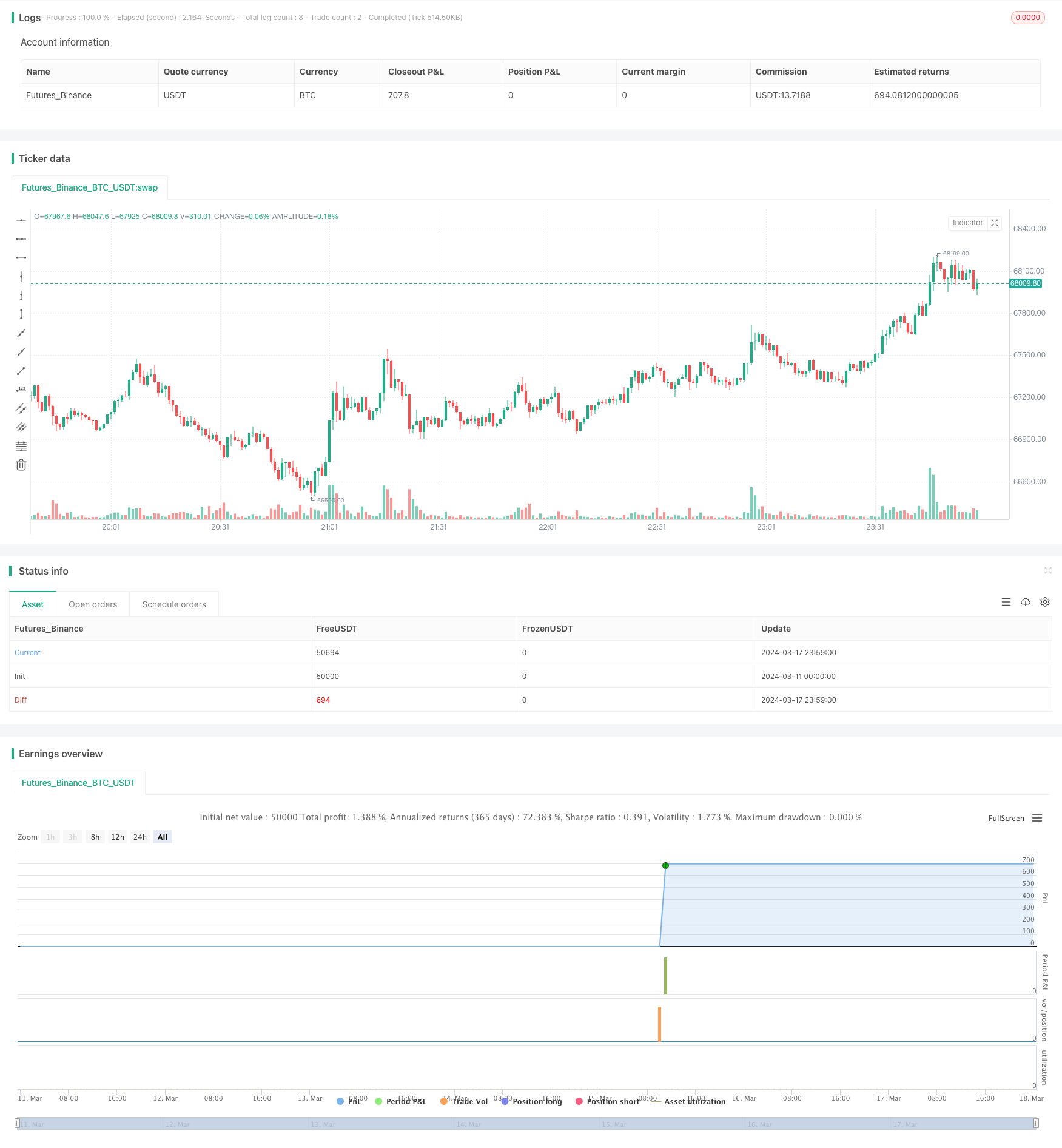
策略概述
基于平均真实波幅(ATR)和相对强弱指数(RSI)的钱德勒出场策略是一种量化交易策略,旨在捕捉市场的趋势反转机会。该策略结合了ATR作为波动率指标和RSI作为动量指标,通过设置钱德勒出场条件、止损和止盈水平来实现自动化交易。
策略原理
该策略的核心原理是利用ATR和RSI两个技术指标来识别潜在的交易机会和风险。具体来说:
ATR用于衡量市场波动率,通过计算一定周期内的真实波幅来反映价格的波动程度。策略使用ATR乘以一个倍数来设置钱德勒出场水平,作为趋势反转的信号。
RSI是一个动量指标,用于识别市场的超买和超卖状态。策略设置了RSI的超买和超卖阈值,当RSI低于超卖水平时,认为市场处于超卖状态,可能出现上涨;当RSI高于超买水平时,认为市场处于超买状态,可能出现下跌。
策略通过结合ATR钱德勒出场和RSI超买超卖条件来产生交易信号。当收盘价突破钱德勒出场上轨且RSI低于超卖水平时,产生做多信号;当收盘价突破钱德勒出场下轨且RSI高于超买水平时,产生做空信号。
在开仓后,策略使用基于ATR的止损和止盈水平来管理风险和利润。止损价格通过ATR乘以一个倍数来计算,以限制潜在损失;止盈价格同样基于ATR来设置,以锁定已获得的利润。
通过动态调整钱德勒出场水平和设置合理的止损止盈,该策略能够适应不同的市场状况,捕捉趋势反转机会并控制风险。
优势分析
基于ATR和RSI的钱德勒出场策略具有以下优势:
趋势适应性:通过使用ATR动态调整钱德勒出场水平,策略能够适应不同的市场波动状况,及时捕捉趋势反转机会。
风险控制:策略内置了基于ATR的止损和止盈机制,能够有效控制单笔交易的风险敞口,防止过度亏损。
参数灵活性:策略提供了多个可调参数,如ATR长度、ATR倍数、RSI长度、超买超卖阈值等,可根据不同市场和资产进行优化,提高适应性。
自动化交易:策略基于明确的交易规则,可以实现自动化执行,减少人为干预和情绪影响,提高交易效率。
风险分析
尽管该策略有其优势,但也存在一些潜在风险:
参数优化风险:策略的表现依赖于参数的选择,不恰当的参数设置可能导致策略失效或表现不佳。因此,需要对参数进行严格的回测和优化。
市场风险:策略在趋势反转和震荡市场中表现可能存在差异,对于某些市场状况,如快速变化的趋势或长期横盘,策略可能效果不佳。
真实交易环境:回测结果与真实交易表现可能存在差异,因为回测环境难以完全模拟真实市场的所有因素,如滑点、交易成本等。
为了应对这些风险,可以采取以下措施:
严格的参数优化和回测:使用足够长的历史数据进行全面的参数优化,并进行样本外测试,确保策略的稳健性。
风险敞口控制:合理设置仓位大小和风险限额,避免过度集中和杠杆,以控制整体风险。
持续监控和调整:实盘交易过程中,密切监控策略表现,根据市场变化适时调整参数或停止交易,以减少潜在损失。
优化方向
该策略还有一些潜在的优化方向,可以进一步提升其性能和适应性,例如:
多空仓:目前策略仅考虑了单向开仓,可以扩展为同时持有多空仓位,以应对不同的市场趋势和震荡。这样可以提高资金利用效率和潜在收益。
动态参数调整:根据市场状态的变化,如趋势强度、波动率等,动态调整策略参数,如ATR倍数、止损止盈水平等,使策略更加适应当前市场。
多因子结合:可以考虑结合其他技术指标或基本面因子,如交易量、市场情绪等,形成更加全面和稳健的交易信号,提高策略的准确性。
资产配置和多元化:将该策略应用于不同的市场和资产,实现跨市场和跨资产的配置,分散风险,捕捉更多的交易机会。
通过不断优化和改进,基于ATR和RSI的钱德勒出场策略可以成为一个更加完善和有效的量化交易工具。
总结
基于平均真实波幅和相对强弱指数的钱德勒出场策略是一种量化交易方法,通过动态调整出场条件和设置止损止盈,以捕捉市场趋势反转机会。该策略利用了ATR衡量波动率和RSI判断超买超卖状态,生成开仓信号并管理风险。
策略的优势在于其趋势适应性、风险控制、参数灵活性和自动化交易能力。同时,策略也面临参数优化、市场变化和真实交易环境等风险,需要采取严格的回测优化、风险敞口控制和持续监控调整等措施来应对。
未来,该策略可以通过引入多空仓、动态参数调整、多因子结合和资产配置等方面进行优化,以进一步提升其性能和适应性。
总的来说,基于ATR和RSI的钱德勒出场策略为量化交易提供了一种可行的思路。通过合理运用该策略并结合其他量化交易技术和风险管理手段,投资者可以在动态变化的市场环境中把握交易机会,实现稳健的投资回报。量化交易策略的成功取决于对策略原理的深入理解、严谨的回测优化过程以及在实际交易中的灵活应用和风险控制。不断学习和完善量化交易策略,是提高交易水平和投资业绩的关键。
/*backtest
start: 2024-03-11 00:00:00
end: 2024-03-18 00:00:00
period: 1m
basePeriod: 1m
exchanges: [{"eid":"Futures_Binance","currency":"BTC_USDT"}]
*/
//@version=5
strategy("ATR Chandelier Exit Strategy with Stop Loss and Take Profit", overlay=true)
// Parameters
atr_length = input(8, title="ATR Length")
atr_multiplier = input(3, title="ATR Multiplier")
rsi_length = input(11, title="RSI Length")
rsi_oversold = input(20, title="RSI Oversold Level")
rsi_overbought = input(80, title="RSI Overbought Level")
stop_loss_atr = input(2, title="Stop Loss ATR Multiplier")
take_profit_atr = input(1, title="Take Profit ATR Multiplier")
// Calculate ATR
atr_value = ta.atr(atr_length)
// Calculate Chandelier Exit
chandelier_exit_long = ta.highest(high, atr_length) - atr_value * atr_multiplier
chandelier_exit_short = ta.lowest(low, atr_length) + atr_value * atr_multiplier
// Calculate RSI
rsi = ta.rsi(close, rsi_length)
// Strategy conditions
long_condition = ta.crossover(close, chandelier_exit_long) and rsi < rsi_oversold
short_condition = ta.crossunder(close, chandelier_exit_short) and rsi > rsi_overbought
// Execute trades
if (long_condition)
strategy.entry("Long", strategy.long)
strategy.exit("Exit Long", "Long", stop=close - stop_loss_atr * atr_value, limit=close + take_profit_atr * atr_value)
if (short_condition)
strategy.entry("Short", strategy.short)
strategy.exit("Exit Short", "Short", stop=close + stop_loss_atr * atr_value, limit=close - take_profit_atr * atr_value)
// Plot buy and sell signals
plotshape(series=long_condition, location=location.belowbar, color=color.green, style=shape.labelup, text="Buy")
plotshape(series=short_condition, location=location.abovebar, color=color.red, style=shape.labeldown, text="Sell")